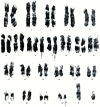Molecular, Cytogenetic, and Hematological Analysis of Chronic Myeloid Leukemia Patients and Discovery of Two Novel Translocations
- PMID: 34422550
- PMCID: PMC8378985
- DOI: 10.1155/2021/4909012
Molecular, Cytogenetic, and Hematological Analysis of Chronic Myeloid Leukemia Patients and Discovery of Two Novel Translocations
Abstract
Chronic myeloid leukemia (CML) is a disease of hematopoietic stem cells and is caused by the balanced translocations among the long arms of chromosomes 9 and 22, which are called the Philadelphia (Ph) chromosome. In this study, 131 CML patients were enrolled. Complete blood cell count was performed at the time of diagnosis for all the patients. Cytogenetic (karyotyping) examination using bone marrow samples was conducted on 76 CML patients for the confirmation of Ph-positive (9;22)(q34;q11) standard translocation, complex variant translocation, and additional chromosome abnormalities. FISH was performed on 38 patients for diagnostic purposes and on 39 patients for monitoring purposes. Twenty-two samples of CML patients were evaluated by reverse transcriptase PCR and real-time PCR for the patients who failed to respond against imatinib mesylate. In this study, 72 (54.96%) were males and 59 (45.03%) were females with a median age of 38.5 years. CBC values in the diagnosis process showed that 75 patients had high values of WBC being >100 × 103/μl, while 71 (58.01) patients exhibited reduced values of hemoglobin, i.e., <10.00 mg/dl, and high values of PLTs > 100 were observed in 40 (30.53%) patients. Cytogenetic results show that standard translocation was developed in 63 (82.89%), development of complex variant translocations in 4 (5.32%), additional chromosomal abnormalities (ACAs) in 3 (3.94%), and ACAs together with complex variant translocations in 1 (1.31%) patient. At the time of diagnosis, 61 (92.95%) patients were in the chronic phase, 4 (5.63%) were in the accelerated phase, and only 1 (1.40%) was in the blast crisis. Out of twenty-two patients, only 6 CML patients who were shifted from imatinib mesylate to nilotinib showed BCR-ABL-positive amplification. However, only 7 out of twenty-one patients exhibit BCR-ABL gene values ≥ 1 after three months of follow-up when analyzed by the quantitative real-time PCR. In conclusion, we found a novel five-way translocation 46XX,t(1;2;2;17;9;22)(p36.3,q21;q11.2,q21,q34,q11.2) and a novel four-way complex variant translocation 48XY,+8(8;17)(9;22),+der(22)(q11.2;q23)(q34;q11.2) in the accelerated phase.
Copyright © 2021 Muhammad Asif et al.
Conflict of interest statement
All authors declare that they have no conflict of interest.
Figures









References
MeSH terms
Substances
LinkOut - more resources
Full Text Sources
Medical
Research Materials
Miscellaneous

